
A simple vibration problem
A centered finite difference scheme; step 1 and 2
A centered finite difference scheme; step 3
A centered finite difference scheme; step 4
Computing the first step
The computational algorithm
Operator notation; ODE
Operator notation; initial condition
Computing \( u' \)
Implementation
Core algorithm
Plotting
Main program
User interface: command line
Running the program
Verification
First steps for testing and debugging
Checking convergence rates
Implementational details
Nose test
Long time simulations
Effect of the time step on long simulations
Using a moving plot window
Analysis of the numerical scheme
Deriving an exact numerical solution; ideas
Deriving an exact numerical solution; calculations (1)
Deriving an exact numerical; calculations (2)
Polynomial approximation of the phase error
Plot of the phase error
Exact discrete solution
Convergence of the numerical scheme
Stability
The stability criterion
Summary of the analysis
Alternative schemes based on 1st-order equations
Rewriting 2nd-order ODE as system of two 1st-order ODEs
The Forward Euler scheme
The Backward Euler scheme
The Crank-Nicolson scheme
Comparison of schemes via Odespy
Forward and Backward Euler and Crank-Nicolson
Phase plane plot of the numerical solutions
Plain solution curves
Observations from the figures
Runge-Kutta methods of order 2 and 4; short time series
Runge-Kutta methods of order 2 and 4; longer time series
Crank-Nicolson; longer time series
Observations of RK and CN methods
Energy conservation property
Derivation of the energy conservation property
Remark about \( E(t) \)
The Euler-Cromer method; idea
The Euler-Cromer method; complete formulas
Equivalence with the scheme for the second-order ODE
Comparison of the treatment of initial conditions
A method utilizing a staggered mesh
Centered differences on a staggered mesh
Comparison with the scheme for the 2nd-order ODE
Implementation of a staggered mesh; integer indices
Implementation of a staggered mesh; half-integer indices (1)
Implementation of a staggered mesh; half-integer indices (2)
Generalization: damping, nonlinear spring, and external excitation
A centered scheme for linear damping
Initial conditions
Linearization via a geometric mean approximation
A centered scheme for quadratic damping
Initial condition for quadratic damping
Algorithm
Implementation
Verification
Demo program
Euler-Cromer formulation
Staggered grid
Linear damping
Quadratic damping
Initial conditions
$$ \begin{equation} u''t + \omega^2u = 0,\quad u(0)=I,\ u'(0)=0,\ t\in (0,T] \tp \label{vib:model1} \end{equation} $$
Exact solution:
$$ \begin{equation} u(t) = I\cos (\omega t) \tp \label{vib:model1:uex} \end{equation} $$ \( u(t) \) oscillates with constant amplitude \( I \) and (angular) frequency \( \omega \). Period: \( P=2\pi/\omega \).
Step 3: Approximate derivative(s) by finite difference approximation(s). Very common (standard!) formula for \( u'' \):
$$ \begin{equation} u''(t_n) \approx \frac{u^{n+1}-2u^n + u^{n-1}}{\Delta t^2} \tp \label{vib:model1:step3} \end{equation} $$
Use this discrete initial condition together with the ODE at \( t=0 \) to eliminate \( u^{-1} \) (insert \eqref{vib:model1:step3} in \eqref{vib:model1:step2}):
$$ \begin{equation} \frac{u^{n+1}-2u^n + u^{n-1}}{\Delta t^2} = -\omega^2 u^n \tp \label{vib:model1:step4a} \end{equation} $$
Step 4: Formulate the computational algorithm. Assume \( u^{n-1} \) and \( u^n \) are known, solve for unknown \( u^{n+1} \):
$$ \begin{equation} u^{n+1} = 2u^n - u^{n-1} - \Delta t^2\omega^2 u^n \tp \label{vib:model1:step4} \end{equation} $$
Nick names for this scheme: Stormer's method or Verlet integration.
Inserted in \eqref{vib:model1:step4} for \( n=0 \) gives
$$ \begin{equation} u^1 = u^0 - \half \Delta t^2 \omega^2 u^0 \tp \label{vib:model1:step4b} \end{equation} $$
t = linspace(0, T, Nt+1) # mesh points in time
dt = t[1] - t[0] # constant time step.
u = zeros(Nt+1) # solution
u[0] = I
u[1] = u[0] - 0.5*dt**2*w**2*u[0]
for n in range(1, Nt):
u[n+1] = 2*u[n] - u[n-1] - dt**2*w**2*u[n]
Note: w is consistently used for \( \omega \) in my code.
With \( [D_tD_t u]^n \) as the finite difference approximation to \( u''(t_n) \) we can write
$$ \begin{equation} [D_tD_t u + \omega^2 u = 0]^n \tp \label{vib:model1:step4:op} \end{equation} $$
\( [D_tD_t u]^n \) means applying a central difference with step \( \Delta t/2 \) twice:
$$ [D_t(D_t u)]^n = \frac{[D_t u]^{n+\half} - [D_t u]^{n-\half}}{\Delta t}$$ which is written out as $$ \frac{1}{\Delta t}\left(\frac{u^{n+1}-u^n}{\Delta t} - \frac{u^{n}-u^{n-1}}{\Delta t}\right) = \frac{u^{n+1}-2u^n + u^{n-1}}{\Delta t^2} \tp $$
$$ \begin{equation} [u = I]^0,\quad [D_{2t} u = 0]^0, \end{equation} $$ where \( [D_{2t} u]^n \) is defined as $$ \begin{equation} [D_{2t} u]^n = \frac{u^{n+1} - u^{n-1}}{2\Delta t} \tp \end{equation} $$
\( u \) is often displacement/position, \( u' \) is velocity and can be computed by
$$ \begin{equation} u'(t_n) \approx \frac{u^{n+1}-u^{n-1}}{2\Delta t} = [D_{2t}u]^n \tp \end{equation} $$
from numpy import *
from matplotlib.pyplot import *
from vib_empirical_analysis import minmax, periods, amplitudes
def solver(I, w, dt, T):
"""
Solve u'' + w**2*u = 0 for t in (0,T], u(0)=I and u'(0)=0,
by a central finite difference method with time step dt.
"""
dt = float(dt)
Nt = int(round(T/dt))
u = zeros(Nt+1)
t = linspace(0, Nt*dt, Nt+1)
u[0] = I
u[1] = u[0] - 0.5*dt**2*w**2*u[0]
for n in range(1, Nt):
u[n+1] = 2*u[n] - u[n-1] - dt**2*w**2*u[n]
return u, t
def exact_solution(t, I, w):
return I*cos(w*t)
def visualize(u, t, I, w):
plot(t, u, 'r--o')
t_fine = linspace(0, t[-1], 1001) # very fine mesh for u_e
u_e = exact_solution(t_fine, I, w)
hold('on')
plot(t_fine, u_e, 'b-')
legend(['numerical', 'exact'], loc='upper left')
xlabel('t')
ylabel('u')
dt = t[1] - t[0]
title('dt=%g' % dt)
umin = 1.2*u.min(); umax = -umin
axis([t[0], t[-1], umin, umax])
savefig('vib1.png')
savefig('vib1.pdf')
savefig('vib1.eps')
I = 1
w = 2*pi
dt = 0.05
num_periods = 5
P = 2*pi/w # one period
T = P*num_periods
u, t = solver(I, w, dt, T)
visualize(u, t, I, w, dt)
import argparse
parser = argparse.ArgumentParser()
parser.add_argument('--I', type=float, default=1.0)
parser.add_argument('--w', type=float, default=2*pi)
parser.add_argument('--dt', type=float, default=0.05)
parser.add_argument('--num_periods', type=int, default=5)
a = parser.parse_args()
I, w, dt, num_periods = a.I, a.w, a.dt, a.num_periods
Terminal> python vib_undamped.py --dt 0.05 --num_periods 40
Generates frames tmp_vib%04d.png in files. Can make movie:
Terminal> avconv -r 12 -i tmp_vib%04d.png -vcodec flv movie.flv
Can use ffmpeg instead of avconv.
| Format | Codec and filename |
| Flash | -vcodec flv movie.flv |
| MP4 | -vcodec libx64 movie.mp4 |
| Webm | -vcodec libvpx movie.webm |
| Ogg | -vcodec libtheora movie.ogg |
The next function estimates convergence rates, i.e., it
def convergence_rates(m, num_periods=8):
"""
Return m-1 empirical estimates of the convergence rate
based on m simulations, where the time step is halved
for each simulation.
"""
w = 0.35; I = 0.3
dt = 2*pi/w/30 # 30 time step per period 2*pi/w
T = 2*pi/w*num_periods
dt_values = []
E_values = []
for i in range(m):
u, t = solver(I, w, dt, T)
u_e = exact_solution(t, I, w)
E = sqrt(dt*sum((u_e-u)**2))
dt_values.append(dt)
E_values.append(E)
dt = dt/2
r = [log(E_values[i-1]/E_values[i])/
log(dt_values[i-1]/dt_values[i])
for i in range(1, m, 1)]
return r
Result: r contains values equal to 2.00 - as expected!
Use final r[-1] in a unit test:
def test_convergence_rates():
r = convergence_rates(m=5, num_periods=8)
# Accept rate to 1 decimal place
nt.assert_almost_equal(r[-1], 2.0, places=1)
Complete code in vib_undamped.py.

scitools.MovingPlotWindow.scitools.avplotter (ASCII vertical plotter).
Terminal> python vib_undamped.py --dt 0.05 --num_periods 40
Movie of the moving plot window.
$$ u^n = IA^n = I\exp{(\tilde\omega \Delta t\, n)}=I\exp{(\tilde\omega t)} = I\cos (\tilde\omega t) + iI\sin(\tilde \omega t) \tp $$
$$ \begin{align*} [D_tD_t u]^n &= \frac{u^{n+1} - 2u^n + u^{n-1}}{\Delta t^2}\\ &= I\frac{A^{n+1} - 2A^n + A^{n-1}}{\Delta t^2}\\ &= I\frac{\exp{(i\tilde\omega(t+\Delta t))} - 2\exp{(i\tilde\omega t)} + \exp{(i\tilde\omega(t-\Delta t))}}{\Delta t^2}\\ &= I\exp{(i\tilde\omega t)}\frac{1}{\Delta t^2}\left(\exp{(i\tilde\omega(\Delta t))} + \exp{(i\tilde\omega(-\Delta t))} - 2\right)\\ &= I\exp{(i\tilde\omega t)}\frac{2}{\Delta t^2}\left(\cosh(i\tilde\omega\Delta t) -1 \right)\\ &= I\exp{(i\tilde\omega t)}\frac{2}{\Delta t^2}\left(\cos(\tilde\omega\Delta t) -1 \right)\\ &= -I\exp{(i\tilde\omega t)}\frac{4}{\Delta t^2}\sin^2(\frac{\tilde\omega\Delta t}{2}) \end{align*} $$
The scheme \eqref{vib:model1:step4} with \( u^n=I\exp{(i\omega\tilde\Delta t\, n)} \) inserted gives
$$ \begin{equation} -I\exp{(i\tilde\omega t)}\frac{4}{\Delta t^2}\sin^2(\frac{\tilde\omega\Delta t}{2}) + \omega^2 I\exp{(i\tilde\omega t)} = 0, \end{equation} $$ which after dividing by \( Io\exp{(i\tilde\omega t)} \) results in $$ \begin{equation} \frac{4}{\Delta t^2}\sin^2(\frac{\tilde\omega\Delta t}{2}) = \omega^2 \tp \end{equation} $$ Solve for \( \tilde\omega \): $$ \begin{equation} \tilde\omega = \pm \frac{2}{\Delta t}\sin^{-1}\left(\frac{\omega\Delta t}{2}\right) \tp \label{vib:model1:tildeomega} \end{equation} $$
Taylor series expansion for small \( \Delta t \) gives a formula that is easier to understand:
>>> from sympy import *
>>> dt, w = symbols('dt w')
>>> w_tilde = asin(w*dt/2).series(dt, 0, 4)*2/dt
>>> print w_tilde
(dt*w + dt**3*w**3/24 + O(dt**4))/dt # observe final /dt
$$ \begin{equation} \tilde\omega = \omega\left( 1 + \frac{1}{24}\omega^2\Delta t^2\right) + {\cal O}(\Delta t^3) \tp \label{vib:model1:tildeomega:series} \end{equation} $$ The numerical frequency is too large (to fast oscillations).

Recommendation: 25-30 points per period.
$$ \begin{equation} u^n = I\cos\left(\tilde\omega n\Delta t\right),\quad \tilde\omega = \frac{2}{\Delta t}\sin^{-1}\left(\frac{\omega\Delta t}{2}\right) \tp \label{vib:model1:un:exact} \end{equation} $$
The error mesh function,
$$ e^n = \uex(t_n) - u^n = I\cos\left(\omega n\Delta t\right) - I\cos\left(\tilde\omega n\Delta t\right) $$ is ideal for verification and analysis.
Can easily show convergence:
$$ e^n\rightarrow 0 \hbox{ as }\Delta t\rightarrow 0,$$ because
$$
\lim_{\Delta t\rightarrow 0}
\tilde\omega = \lim_{\Delta t\rightarrow 0}
\frac{2}{\Delta t}\sin^{-1}\left(\frac{\omega\Delta t}{2}\right)
= \omega,
$$
by L'Hopital's rule or simply asking
(2/x)*asin(w*x/2) as x->0 in WolframAlpha.
Observations:
Cannot tolerate growth and must therefore demand a stability criterion $$ \begin{equation} \frac{\omega\Delta t}{2} \leq 1\quad\Rightarrow\quad \Delta t \leq \frac{2}{\omega} \tp \end{equation} $$
Try \( \Delta t = \frac{2}{\omega} + 9.01\cdot 10^{-5} \) (slightly too big!):
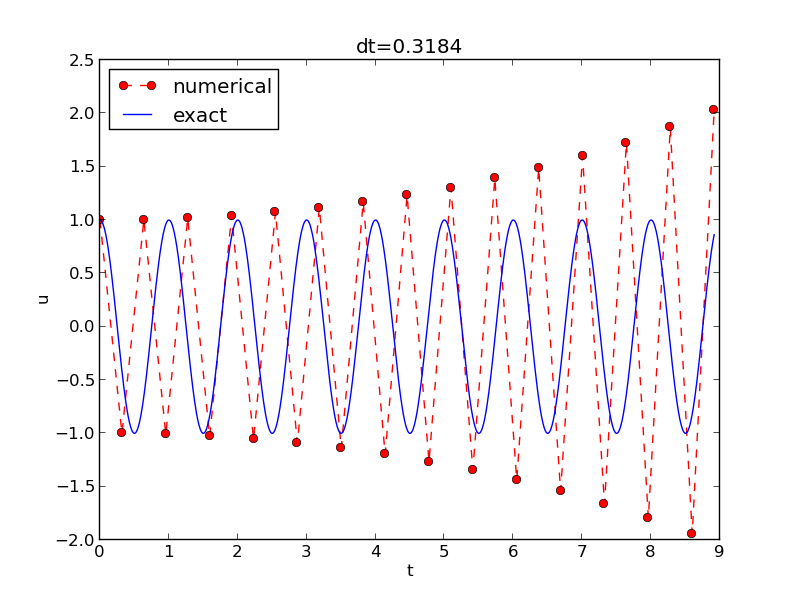
We can draw three important conclusions:
The vast collection of ODE solvers (e.g., in Odespy) cannot be applied to $$ u'' + \omega^2 u = 0$$ unless we write this higher-order ODE as a system of 1st-order ODEs.
Introduce an auxiliary variable \( v=u' \):
$$ \begin{align} u' &= v, \label{vib:model2x2:ueq}\\ v' &= -\omega^2 u \label{vib:model2x2:veq} \tp \end{align} $$
Initial conditions: \( u(0)=I \) and \( v(0)=0 \).
We apply the Forward Euler scheme to each component equation:
$$ [D_t^+ u = v]^n,$$
$$ [D_t^+ v = -\omega^2 u]^n,$$ or written out,
$$ \begin{align} u^{n+1} &= u^n + \Delta t v^n,\\ v^{n+1} &= v^n -\Delta t \omega^2 u^n \tp \end{align} $$
We apply the Backward Euler scheme to each component equation:
$$ [D_t^- u = v]^{n+1},$$
$$ [D_t^- v = -\omega u]^{n+1} \tp $$ Written out: $$ \begin{align} u^{n+1} - \Delta t v^{n+1} = u^{n},\\ v^{n+1} + \Delta t \omega^2 u^{n+1} = v^{n} \tp \end{align} $$ This is a coupled \( 2\times 2 \) system for the new values at \( t=t_{n+1} \)!
$$ [D_t u = \overline{v}^t]^{n+\half},$$
$$ [D_t v = -\omega \overline{u}^t]^{n+\half}$$ The result is also a coupled system:
$$ \begin{align} u^{n+1} - \half\Delta t v^{n+1} &= u^{n} + \half\Delta t v^{n},\\ v^{n+1} + \half\Delta t \omega^2 u^{n+1} &= v^{n} - \half\Delta t \omega^2 u^{n} \tp \end{align} $$
Can use Odespy to compare many methods for first-order schemes:
import odespy
import numpy as np
def f(u, t, w=1):
u, v = u # u is array of length 2 holding our [u, v]
return [v, -w**2*u]
def run_solvers_and_plot(solvers, timesteps_per_period=20,
num_periods=1, I=1, w=2*np.pi):
P = 2*np.pi/w # duration of one period
dt = P/timesteps_per_period
Nt = num_periods*timesteps_per_period
T = Nt*dt
t_mesh = np.linspace(0, T, Nt+1)
legends = []
for solver in solvers:
solver.set(f_kwargs={'w': w})
solver.set_initial_condition([I, 0])
u, t = solver.solve(t_mesh)
solvers = [
odespy.ForwardEuler(f),
# Implicit methods must use Newton solver to converge
odespy.BackwardEuler(f, nonlinear_solver='Newton'),
odespy.CrankNicolson(f, nonlinear_solver='Newton'),
]
Two plot types:

Note: CrankNicolson in Odespy leads to the name MidpointImplicit in plots.

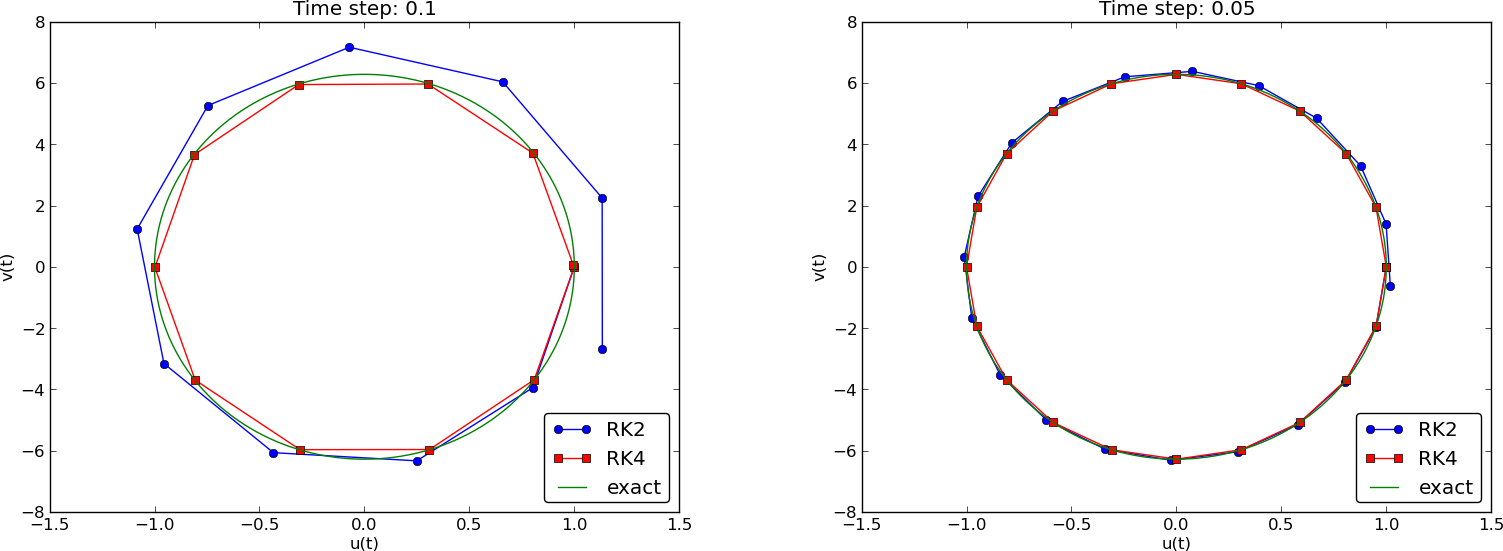
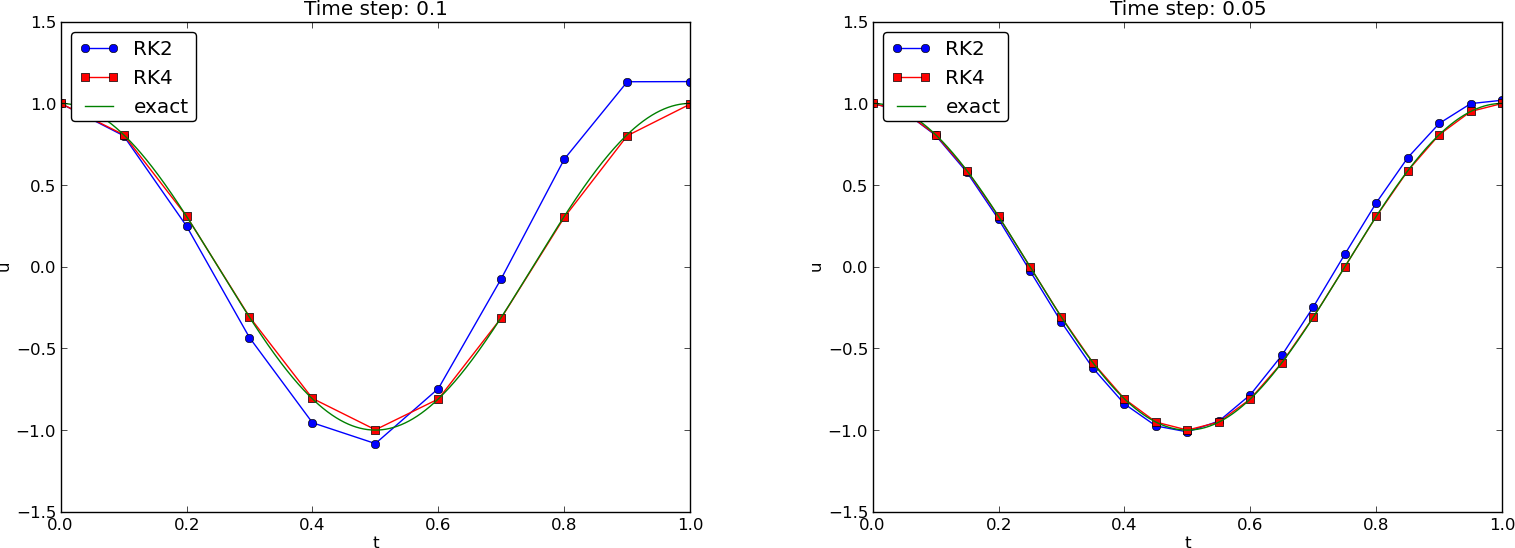
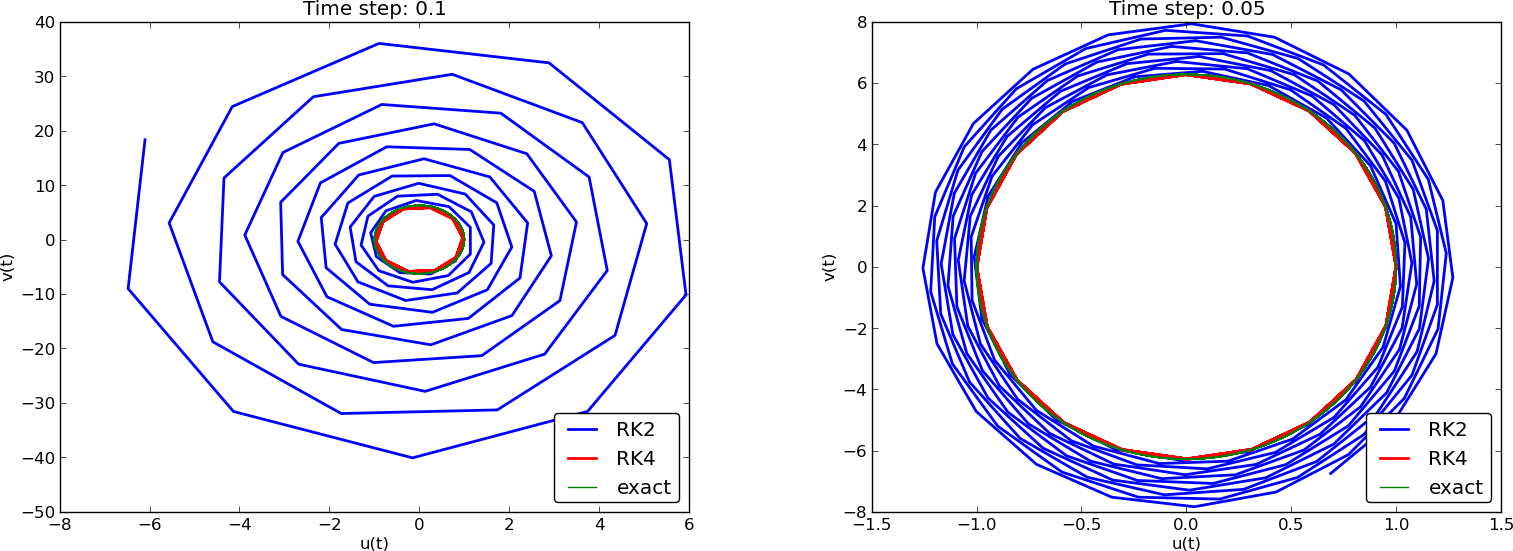


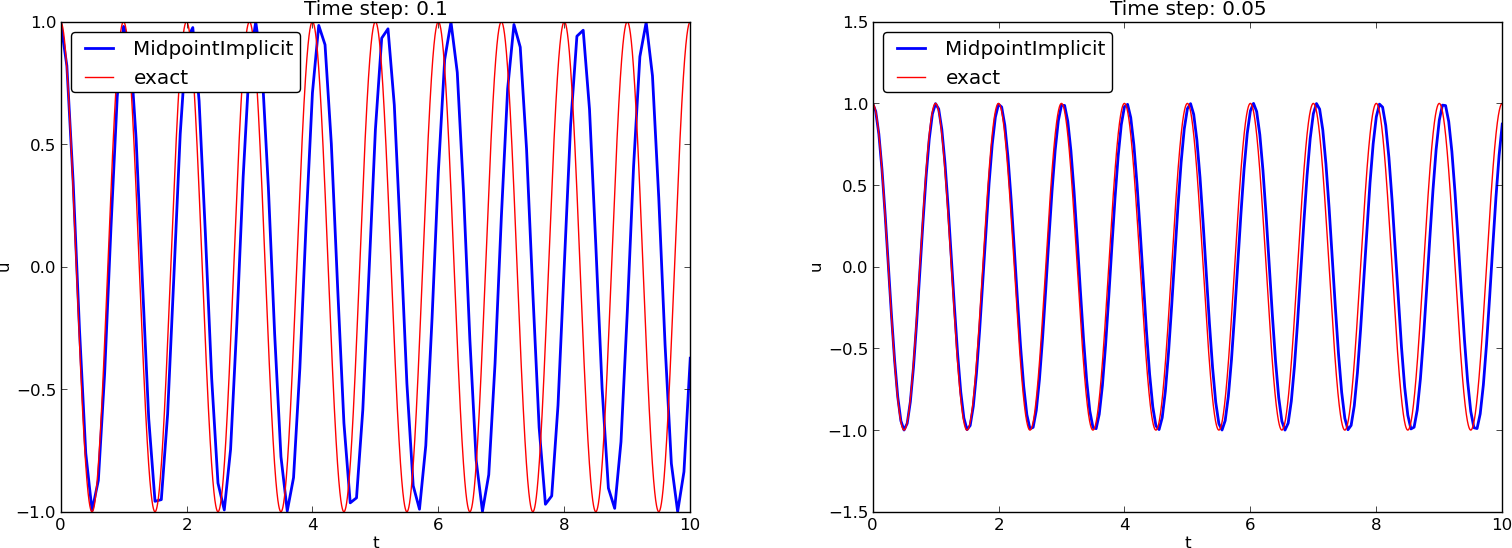
(MidpointImplicit means CrankNicolson in Odespy)
The model
$$ u'' + \omega^2 u = 0,\quad u(0)=I,\ u'(0)=V,$$ has the nice energy conservation property that
$$ E(t) = \half(u')^2 + \half\omega^2u^2 = \hbox{const}\tp$$ This can be used to check solutions.
Multiply \( u''+\omega^2u=0 \) by \( u' \) and integrate:
$$ \int_0^T u''u' dt + \int_0^T\omega^2 u u' dt = 0\tp$$ Observing that
$$ u''u' = \frac{d}{dt}\half(u')^2,\quad uu' = \frac{d}{dt} {\half}u^2,$$ we get
$$ \int_0^T (\frac{d}{dt}\half(u')^2 + \frac{d}{dt} \half\omega^2u^2)dt = E(T) - E(0), $$ where
$$ \begin{equation} E(t) = \half(u')^2 + \half\omega^2u^2\tp \label{vib:model1:energy:balance1} \end{equation} $$
\( E(t) \) does not measure energy, energy per mass unit.
Starting with an ODE coming directly from Newton's 2nd law \( F=ma \) with a spring force \( F=-ku \) and \( ma=mu'' \) (\( a \): acceleration, \( u \): displacement), we have
$$ mu'' + ku = 0$$ Integrating this equation gives a physical energy balance:
$$ E(t) = \underbrace{{\half}mv^2}_{\hbox{kinetic energy} } + \underbrace{{\half}ku^2}_{\hbox{potential energy}} = E(0),\quad v=u' $$ Note: the balance is not valid if we add other terms to the ODE.
Forward-backward discretization of the 2x2 system:
$$ [D_t^-v = -\omega u]^{n+1} \tp $$
Written out:
$$ \begin{align} u^0 &= I,\\ v^0 &= 0,\\ u^{n+1} &= u^n + \Delta t v^n, \label{vib:model2x2:EulerCromer:ueq1}\\ v^{n+1} &= v^n -\Delta t \omega^2u^{n+1} \label{vib:model2x2:EulerCromer:veq1} \tp \end{align} $$
Names: Forward-backward scheme, Semi-implicit Euler method, symplectic Euler, semi-explicit Euler, Newton-Stormer-Verlet, and Euler-Cromer.
Goal: eliminate \( v^n \). We have $$ v^n = v^{n-1} - \Delta t \omega^2u^{n}, $$ which can be inserted in \eqref{vib:model2x2:EulerCromer:ueq1} to yield $$ \begin{equation} u^{n+1} = u^n + \Delta t v^{n-1} - \Delta t^2 \omega^2u^{n} . \label{vib:model2x2:EulerCromer:elim1} \end{equation} $$ Using \eqref{vib:model2x2:EulerCromer:ueq1}, $$ v^{n-1} = \frac{u^n - u^{n-1}}{\Delta t}, $$ and when this is inserted in \eqref{vib:model2x2:EulerCromer:elim1} we get $$ \begin{equation} u^{n+1} = 2u^n - u^{n-1} - \Delta t^2 \omega^2u^{n} \end{equation} $$
This \( u^1=u^0 \) approximation corresponds to a first-order Forward Euler discretization of \( u'(0)=0 \): \( [D_t^+ u = 0]^0 \).
$$ \begin{align} \lbrack D_t u &= v\rbrack^{n+\half},\\ \lbrack D_t v &= -\omega u\rbrack^{n+1} \tp \end{align} $$ Written out:
$$ \begin{align} u^{n+1} &= u^{n} + \Delta t v^{n+\half}, \label{vib:model2x2:EulerCromer:ueq1s}\\ v^{n+\frac{3}{2}} &= v^{n+\half} -\Delta t \omega^2u^{n+1} \label{vib:model2x2:EulerCromer:veq1s} \tp \end{align} $$ or shift one time level back (purely of esthetic reasons):
$$ \begin{align} u^{n} &= u^{n-1} + \Delta t v^{n-\half}, \label{vib:model2x2:EulerCromer:ueq1s2}\\ v^{n+\half} &= v^{n-\half} -\Delta t \omega^2u^{n} \label{vib:model2x2:EulerCromer:veq1s2} \tp \end{align} $$
$$ v(0)\approx \half(v^{-\half} + v^{\half}) = 0, \quad\Rightarrow\quad v^{-\half} =- v^\half\tp$$ Combined with the scheme on the staggered mesh we get
$$ u^1 = u^0 - \half\Delta t^2\omega^2 I,$$
v[i+0.5] does not work...v[n]v[n-1]v[n] = v[n-1] - dt*w**2*u[n]
!bc pycod
def solver(I, w, dt, T):
# set up variables...
u[0] = I
v[0] = 0 - 0.5*dt*w**2*u[0]
for n in range(1, Nt+1):
u[n] = u[n-1] + dt*v[n-1]
v[n] = v[n-1] - dt*w**2*u[n]
return u, t, v, t_v
It would be nice to write
$$ \begin{align*} u^{n} &= u^{n-1} + \Delta t v^{n-\half},\\ v^{n+\half} &= v^{n-\half} -\Delta t \omega^2u^{n}, \end{align*} $$ as
u[n] = u[n-1] + dt*v[n-half]
v[n+half] = v[n-half] - dt*w**2*u[n]
(Implying that n+half is n and n-half is n-1.)
This class ensures that n+half is n and n-half is n-1:
class HalfInt:
def __radd__(self, other):
return other
def __rsub__(self, other):
return other - 1
half = HalfInt()
Now
u[n] = u[n-1] + dt*v[n-half]
v[n+half] = v[n-half] - dt*w**2*u[n]
is equivalent to
u[n] = u[n-1] + dt*v[n-1]
v[n] = v[n-1] - dt*w**2*u[n]
$$ \begin{equation} mu'' + f(u') + s(u) = F(t),\quad u(0)=I,\ u'(0)=V,\ t\in (0,T] \tp \label{vib:ode2} \end{equation} $$ Input data: \( m \), \( f(u') \), \( s(u) \), \( F(t) \), \( I \), \( V \), and \( T \).
Typical choices of \( f \) and \( s \):
$$ \begin{equation} [mD_tD_t u + f(D_{2t}u) + s(u) = F]^n \end{equation} $$ Written out
$$ \begin{equation} m\frac{u^{n+1}-2u^n + u^{n-1}}{\Delta t^2} + f(\frac{u^{n+1}-u^{n-1}}{2\Delta t}) + s(u^n) = F^n \label{vib:ode2:step3b} \end{equation} $$ Assume \( f(u') \) is linear in \( u'=v \):
$$ \begin{equation} u^{n+1} = \left(2mu^n + (\frac{b}{2}\Delta t - m)u^{n-1} + \Delta t^2(F^n - s(u^n)) \right)(m + \frac{b}{2}\Delta t)^{-1} \label{vib:ode2:step4} \tp \end{equation} $$
\( u(0)=I \), \( u'(0)=V \):
$$ \begin{align} \lbrack u &=I\rbrack^0\quad\Rightarrow\quad u^0=I,\\ \lbrack D_{2t}u &=V\rbrack^0\quad\Rightarrow\quad u^{-1} = u^{1} - 2\Delta t V \end{align} $$ End result:
$$ \begin{equation} u^1 = u^0 + \Delta t\, V + \frac{\Delta t^2}{2m}(-bV - s(u^0) + F^0) \tp \label{vib:ode2:step4b} \end{equation} $$ Same formula for \( u^1 \) as when using a centered scheme for \( u''+\omega u=0 \).
$$ [u'|u'|]^n \approx u'(t_n+{\half})|u'(t_n-{\half})|\tp$$ For \( u' \) at \( t_{n\pm 1/2} \) we use centered difference:
$$ \begin{equation} u'(t_{n+1/2})\approx [D_t u]^{n+\half},\quad u'(t_{n-1/2})\approx [D_t u]^{n-\half} \tp \label{vib:ode2:quad:idea2} \end{equation} $$
After some algebra:
$$ \begin{align} u^{n+1} &= \left( m + b|u^n-u^{n-1}|\right)^{-1}\times \nonumber\\ & \qquad \left(2m u^n - mu^{n-1} + bu^n|u^n-u^{n-1}| + \Delta t^2 (F^n - s(u^n)) \right) \tp \label{vib:ode2:step4:quad} \end{align} $$
Simply use that \( u'=V \) in the scheme when \( t=0 \) (\( n=0 \)):
$$ \begin{equation} [mD_tD_t u + bV|V| + s(u) = F]^0 \end{equation} $$
which gives
$$ \begin{equation} u^1 = u^0 + \Delta t V + \frac{\Delta t^2}{2m}\left(-bV|V| - s(u^0) + F^0\right) \tp \label{vib:ode2:step4b:quad} \end{equation} $$
def solver(I, V, m, b, s, F, dt, T, damping='linear'):
dt = float(dt); b = float(b); m = float(m) # avoid integer div.
Nt = int(round(T/dt))
u = zeros(Nt+1)
t = linspace(0, Nt*dt, Nt+1)
u[0] = I
if damping == 'linear':
u[1] = u[0] + dt*V + dt**2/(2*m)*(-b*V - s(u[0]) + F(t[0]))
elif damping == 'quadratic':
u[1] = u[0] + dt*V + \
dt**2/(2*m)*(-b*V*abs(V) - s(u[0]) + F(t[0]))
for n in range(1, Nt):
if damping == 'linear':
u[n+1] = (2*m*u[n] + (b*dt/2 - m)*u[n-1] +
dt**2*(F(t[n]) - s(u[n])))/(m + b*dt/2)
elif damping == 'quadratic':
u[n+1] = (2*m*u[n] - m*u[n-1] + b*u[n]*abs(u[n] - u[n-1])
+ dt**2*(F(t[n]) - s(u[n])))/\
(m + b*abs(u[n] - u[n-1]))
return u, t
vib.py supports input via the command line:
Terminal> python vib.py --s 'sin(u)' --F '3*cos(4*t)' --c 0.03
This results in a moving window following the function on the screen.

We rewrite
$$ \begin{equation} mu'' + f(u') + s(u) = F(t),\quad u(0)=I,\ u'(0)=V,\ t\in (0,T], \end{equation} $$ as a first-order ODE system
$$ \begin{align} u' &= v, \label{vib:ode2:staggered:ueq} \\ v' &= m^{-1}\left(F(t) - f(v) - s(u)\right)\tp \label{vib:ode2:staggered:veq} \end{align} $$
Written out,
$$ \begin{align} \frac{u^n - u^{n-1}}{\Delta t} &= v^{n-\half}, \label{vib:ode2:staggered:dueq2} \\ \frac{v^{n+\half} - v^{n-\half}}{\Delta t} &= m^{-1}\left(F^n - f(v^n) - s(u^n)\right)\tp \label{vib:ode2:staggered:dveq2} \end{align} $$
Problem: \( f(v^n) \)
With \( f(v)=bv \), we can use an arithmetic mean for \( bv^n \) a la Crank-Nicolson schemes.
$$ \begin{align*} u^n & = u^{n-1} + {\Delta t}v^{n-\half},\\ v^{n+\half} &= \left(1 + \frac{b}{2m}\Delta t\right)^{-1}\left( v^{n-\half} + {\Delta t} m^{-1}\left(F^n - {\half}f(v^{n-\half}) - s(u^n)\right)\right)\tp \end{align*} $$
With \( f(v)=b|v|v \), we can use a geometric mean
$$ b|v^n|v^n\approx b|v^{n-\half}|v^{n+\half}, $$ resulting in
$$ \begin{align*} u^n & = u^{n-1} + {\Delta t}v^{n-\half},\\ v^{n+\half} &= (1 + \frac{b}{m}|v^{n-\half}|\Delta t)^{-1}\left( v^{n-\half} + {\Delta t} m^{-1}\left(F^n - s(u^n)\right)\right)\tp \end{align*} $$
$$ \begin{align} u^0 &= I, \label{vib:ode2:staggered:u0}\\ v^{\half} &= V - \half\Delta t\omega^2I \label{vib:ode2:staggered:v0}\tp \end{align} $$